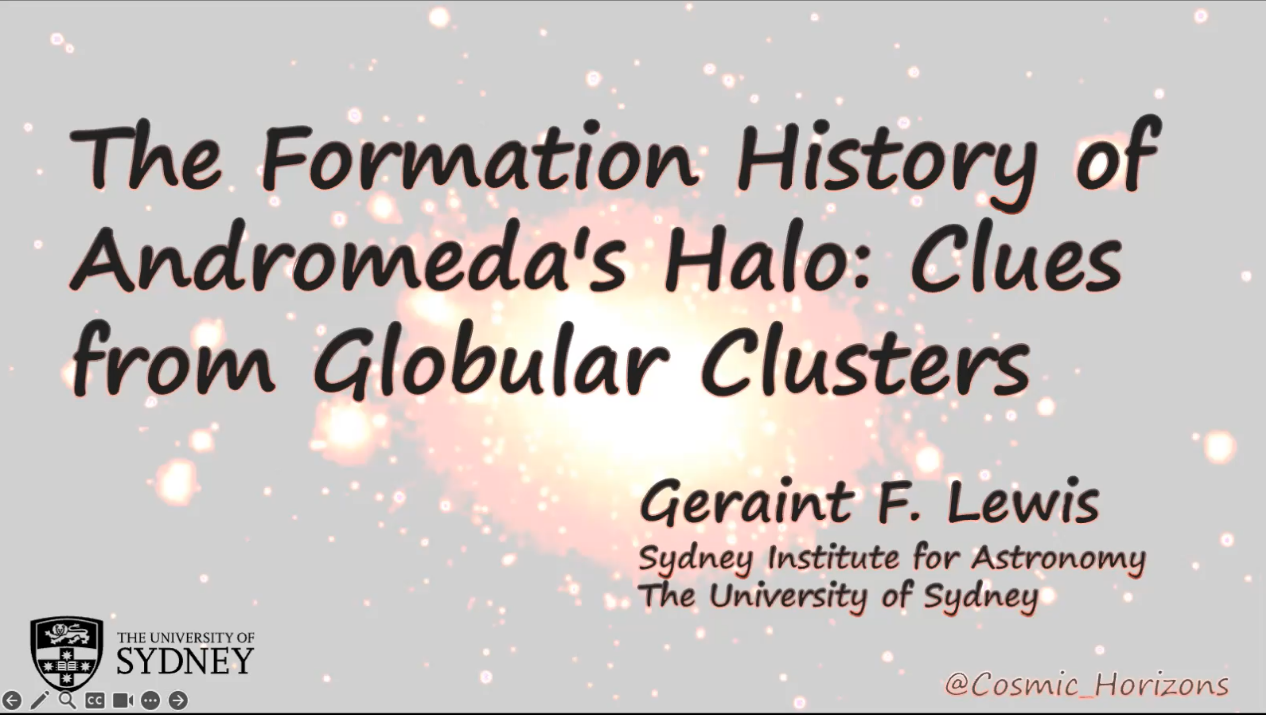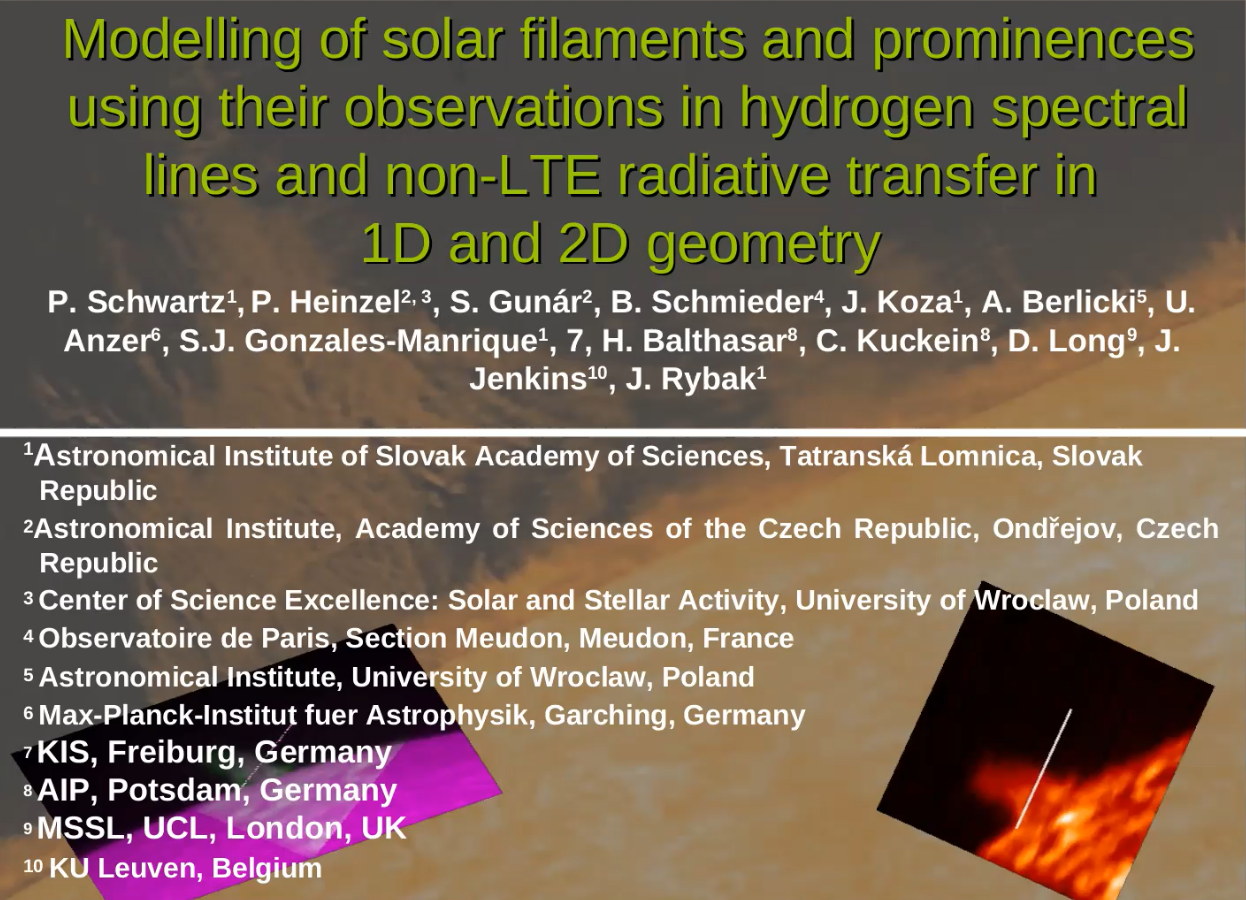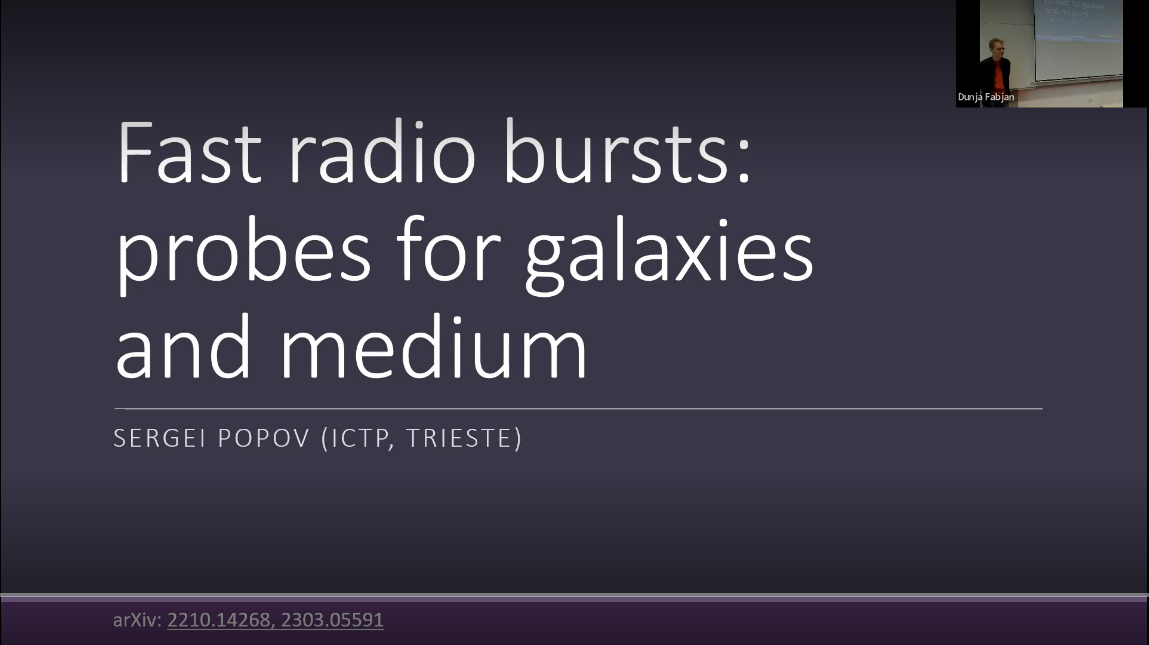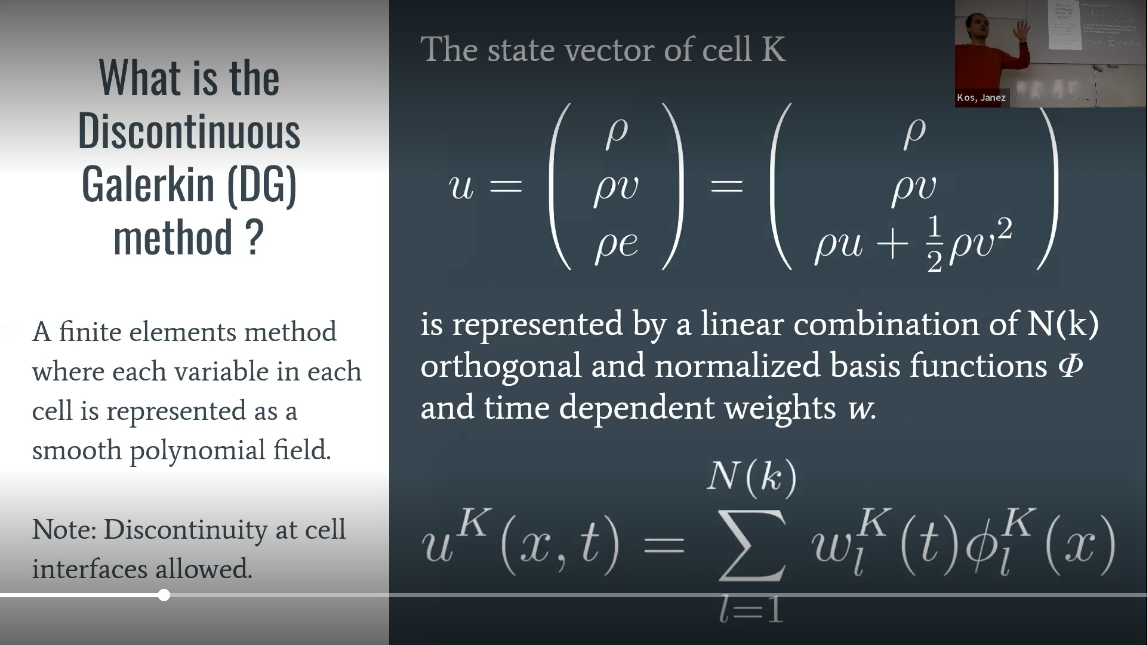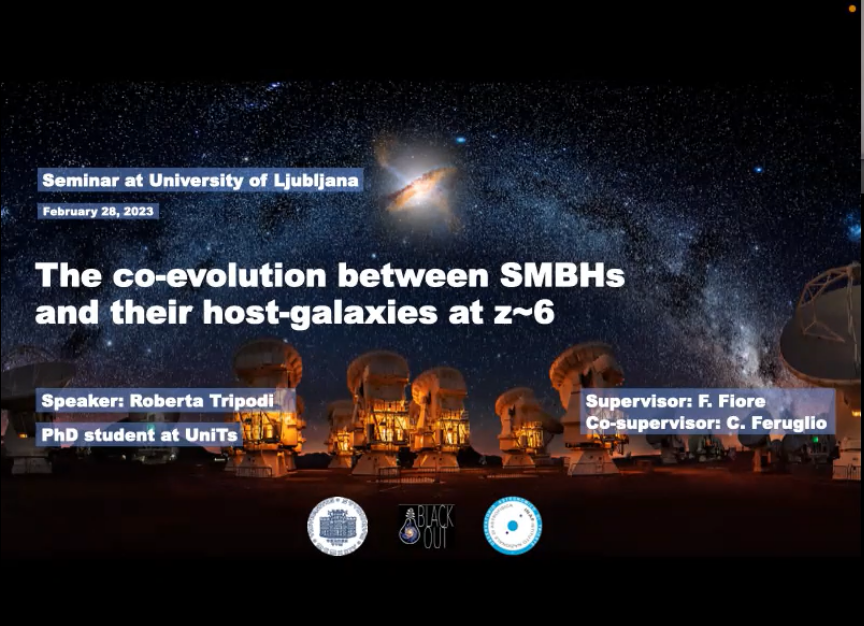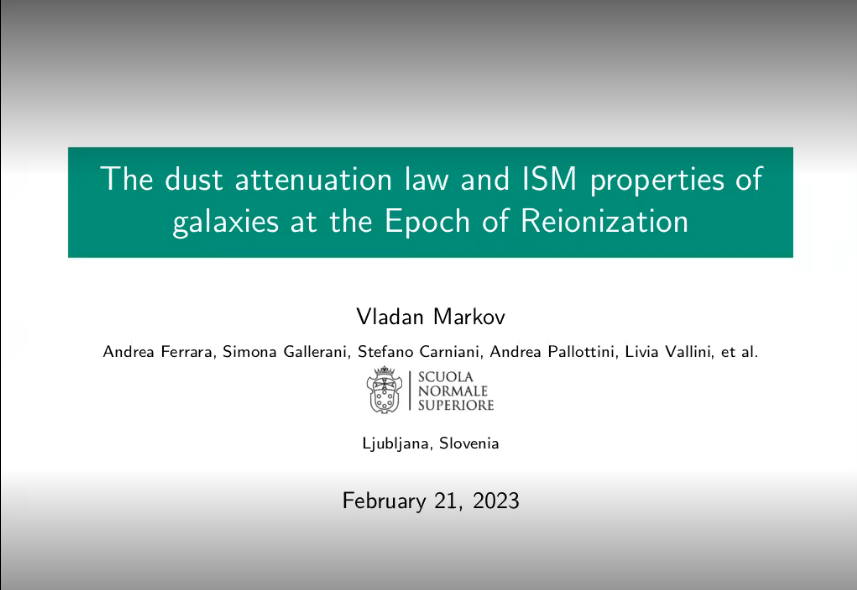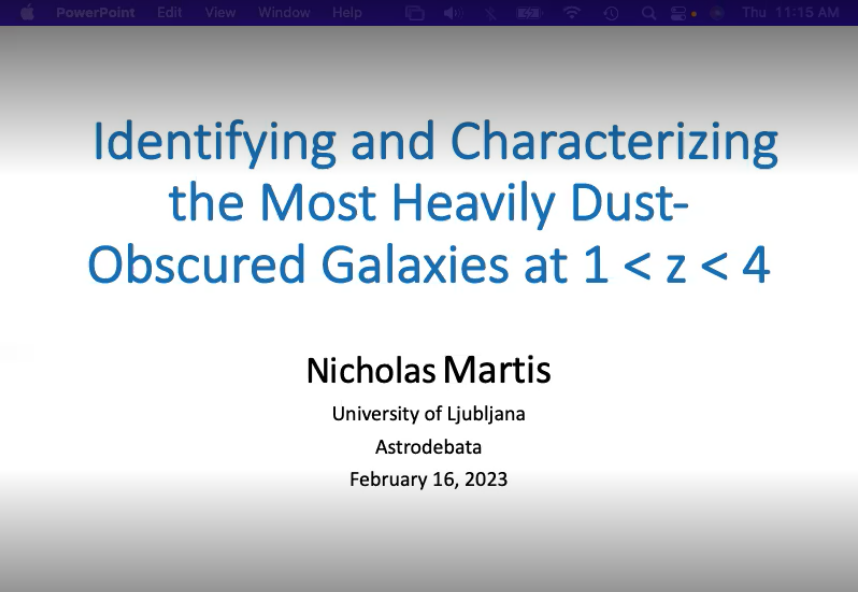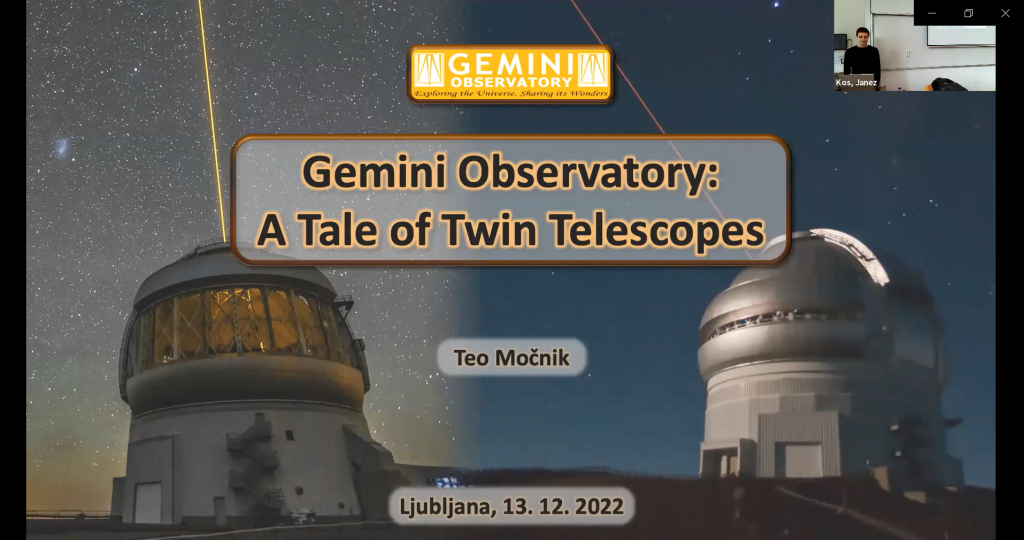Geraint Lewis: The Formation History of Andromeda's Halo: Clues from Globular Clusters
29. junij 2023
Geraint Lewis
(Sydney Institute for Astronomy, The University of Sydney, Australia)
The Pan-Andromeda Archaeological Survey of M31 has revealed a wealth of globular clusters out to 150 kpc. Roughly half of these halo globular clusters are associated with stellar substructures, streams, shells, and debris of tidally disrupting systems, whilst the remainder are not. A kinematic analysis of these two populations reveals distinct, orthogonal rotation signatures, suggestive of two distinct, separate accretion events, one ancient and the other modern. As well as exploring the implications of this result, I also explore the inner globular clusters of Andromeda, finding the outer halo kinematics imprinted on this inner sample, and providing further evidence for distinct accretion events into the halo.
Video is published on this link!
Pavol Schwartz: Modelling of solar filaments and prominences with non-LTE radiative transfer in 1D and 2D
21. junij 2023
Pavol Schwartz
(Astronomical Institute of Slovak Academy of Sciences Tatranska, Lomnica, Slovak Republic)
I present a review of modelling of solar prominences and filaments observed spectroscopically in the Lyman line series of hydrogen and in Hα using detailed non-LTE radiative transfer from the year 2006 up. The so-called ’forward modelling’ was used, it means that extended catalogues of synthetic profiles were calculated and the best model was searched by chi-square minimization between synthetic and observed spectral line profiles.
The modelling was made for diagnostics of hydrogen plasma of both quiescent and active prominences/filaments to understand better their nature and also physical processes leading to their possible activation. Prominence/filament was approximated by a geometrically simple slab. A possibility of increase of temperature towards the slab edges – so called prominence-corona transition regions – were also introduced into the modelling, because their occurrence in peripheral parts of filaments/prominences is evident from observations.
We started with the modelling in 1D geometry, but in 2010 we realized a necessity of 2D geometry, because profiles from peripheral parts of filaments/prominences could not be fitted reliably when the slab in the 1D geometry is irradiated from the solar surface only at its bottom. On the other hand, 2D slab is irradiated both from its bottom and sides. Later, magnetohydrostatic equilibrium and fine structure (multi-slabs) was applied.
Now, we are addopting the 2D-slab codes also for modelling of eruptive prominences and we are calculating grids of models containing synthetic Lyman α intensities which will be later compared with observations in the Lyman α channel made by the METIS coronograph on board of the Solar Orbiter satellite.
Video is published on this link!
Andrej Prša: PHOEBE: PHysics Of Eclipsing BinariEs
19. junij 2023
Prof. dr. Andrej Prša (Villanova University, USA)
PHOEBE: PHysics Of Eclipsing BinariEs is an advanced modeling code for single and binary stars. Its birth place, University of Ljubljana’s Department of Physics, with support from the National Science Foundation, is hosting a 5th annual workshop the week of June 19-23, 2023. In this introductory review I will talk about the road from humble beginnings, where PHOEBE started as a front-end to the venerable Wilson-Devinney code, to becoming one of the de-facto standards in stellar astrophysics. I will emphasize both the observational aspects and the modeling approaches to eclipsing binary data, and showcase some truly exceptional light curves from NASA’s Kepler and TESS missions.
No video available!
Sergey Popov: Fast radio bursts: probes for galaxies and medium
20. april 2023
Sergey Popov (International Center for Theoretical Physics and Sternberg Astronomical Institute of MSU)
Fast radio bursts are a relatively new phenomenon discovered just 15 years ago. They are bright extragalactic radio bursts with typical durations from a fraction of a millisecond up to a few tens of millisecond. Discovery of similar events simultaneously with high energy bursts from one of the Galactic magnetar confirms the hypothesis that powerful episodes of magnetic energy release in neutron stars can be accompanied by radio flares. There are many unsolved problems related to FRBs (emission mechanism, origin of the magnetars, etc.). Still, already now FRBs are actively used as probes of curcumgalactic and intergalactic medium. Also, important cosmological parameters can be derived from FRB observations. In near future, the role of FRBs as extragalactic and cosmological probes will grow. In the talk I review astrophysics of FRBs focusing on their host galaxies and derived properties of circumgalactic and intergalactic medium.
Video is published on this link
Miha Černetič: Driven Turbulence using Discontinuous Galerkin Hydrodynamics on GPUs
29. junij 2023
High-order Discontinuous Galerkin methods are characterised by superior convergence rates and high computational efficiency, making them particularly promising for the high Reynolds numbers and huge dynamic range of astrophysical turbulence as encountered in many different systems, including the gas kinematic and structure of the ISM, the influence turbulence has on star formation and general CGM modelling.
I will present a novel multi-GPU/multi-node realisation of Discontinuous Galerkin hydrodynamics written in CUDA and discuss how we cope with physical discontinuities such as shocks in this method, which has previously proven problematic in DG at high order. Our new code runs efficiently on different hardware configurations, ranging from a single core on a single node, to all available GPUs and CPUs on large compute clusters using MPI-parallelisation between nodes.
I will describe our development strategy and technical approaches to address drawbacks of GPU computing, including overlapping communication and computation, and minimising non-coalesced memory reads and registry pressure.
I will then discuss the accuracy of the code in test problems, and analyse the weak and strong scaling behaviour of the code, demonstrating that some problems reach a speedup of ~50x on the GPU compared to the CPU version.
Finally, I will present first applications to large, high-order simulations of sub- and supersonic driven turbulence.
Video is published on this link!
Roberta Tripodi: The co-evolution between SMBHs and their host-galaxies at z ∼ 6
28. februar 2023
The cold ISM and dust properties are key elements to understand the assembly and nature of the first QSOs at the Reionization Epoch. In particular, the [CII] and CO lines are bright tracers of the gas content that could be detected from distant galaxies. Measurements of the line widths, profiles and velocity maps of these emission lines reveal important information on the gas kinematics and dynamics. On the other hand, a reliable and accurate determination of the dust properties, through the analysis of the continuum emission, allows us to obtain a precise estimate for the star formation rate of the QSO’s host galaxy. In this talk, I will present results of the gas and dust of QSO J2310+1855 at z ∼ 6 based on the analysis of CO, [CII] and continuum emissions from ALMA kpc-resolution observation. This allowed us to study in detail the gas kinematics in J2310’s host galaxy, to perform a dynamical modelling of the rotation curve and to derive dust properties with high accuracy. I will also show very new results on the dust properties of the most luminous QSO at z > 6, namely QSO J0100+2802. The final goal will be to discuss the evolutionary scenario of these objects, studying the evolutionary path of their SMBHs together with the path of their host galaxies.
Video is published on this link!
Vladan Markov: The dust attenuation law and ISM properties of galaxies at the Epoch of Reionization
21. februar 2023
Vladan Markov (Scuola Normale Superiore di Pisa)
During The Epoch of Reionization (EoR), the first galaxies played a key role in the complete reionization of the Universe by z∼6 and in the metal enrichment of the intergalactic medium. Constraining the properties of early galaxies is fundamental in our understanding of galaxy evolution. Standard approach in characterizing the galaxy properties is through the spectral energy distribution (SED) fitting method with a priori assumption on the dust attenuation law (e.g. ”Calzetti” and SMC). However, the dust properties of high-z sources are not well described by the reddening curves derived for local sources. Constraining the dust attenuation law is important for characterizing the dust properties and the dust production mechanisms, but also the global properties of galaxies in the early Universe.
I will present a new tool, based on the SED fitting method, that allows us to simultaneously characterize the dust attenuation properties along with the global parameters of galaxies, without any a priori assumption on the dust law. The advantage of using this robust model, is its capability to recover the dust attenuation properties reddened by any well-known,or potential new dust curve. We test our tool on the synthetic spectra, and apply it on the James Webb Space Telescope (JWST) observations of a sample of star-forming galaxies at the EoR. Our tool and the new JWST data will provide means to constrain the dust properties of a large sample of galaxies at the EoR. I will also discuss how we combined the emission of two carbon lines, [CIII] λ1909 and [CII]158μm (which trace different phases of the ISM), in order to constrain the ISM conditions (gas density, metallicity and ”burstiness”) of high-z star-forming galaxies (Markov et al. 2022).
Video available on this link!
Nicholas Martis: Identifying and Characterizing the Most Heavily Dust-Obscured Galaxies at 1 < z < 4
16. februar 2023
Nicholas Martis (Saint Mary’s University, Halifax, Canada)
I investigate a sample of color-selected galaxies from the UltraVISTA DR3 survey of the COSMOS field in an effort to identify and characterize the most heavily dust-obscured galaxies at 1<z<4. UV-MIR spectral energy distribution (SED) modeling that allows for extreme obscuration levels reveals a population of massive, dusty galaxies with as much as four magnitudes of extinction in the V-band. We perform a detailed analysis of 65 such galaxies including their full UV-FIR SEDs incorporating Herschel photometry, sizes using Hubble Space Telescope imaging when available, and star formation activity. Finally, a comparison of the physical properties of these galaxies to those of sub-millimeter galaxies as well as Herschel sources matched in redshift and stellar mass explores the overlap of selections based on dust emission rather than dust obscuration.
Teo Močnik: Gemini Observatory: A Tale of Twin Telescopes
14. december 2022
Teo Močnik (Gemini Telescopes)
The Gemini Observatory consists of twin 8.1 m telescopes, located on Mauna Kea in Hawaii and on the mountain of Cerro Pachon in Chile. We will virtually visit one of the telescopes and its control room, inspect our arsenal of optical and infrared instruments, take a peek at the backstage operations of the queue-based observatory, and walk through the gallery of some of our science highlights. Best of all, Slovenian astronomers can apply for Gemini observing time too!
Video: click on the image below!
Dr. Guy Consolmagno: Physical and thermal properties of asteroid-analog meteorites
22. november 2022
dr. Guy Consolmagno, director of the Vatican Observatory
We have measured the physical properties (density, porosity, thermal properties) at low temperature for meteorites in classes closely associated with asteroids that have been sampled or are to be closely studied by spacecraft missions. Our results for CM meteorites (close analogs to asteroids Bennu and Ryugu) and iron meteorites (an important constituent of asteroid Psyche) have important applications in understanding their surface properties, including their contribution to Yarkovsky and YORP forces.
Video: click on the image below!
Kelsey Glazer: Carbon at Cosmic Dawn
24. oktober 2022
Kelsey Glazer (UC Davis)
Carbon at Cosmic Dawn is an on-going project that aims to study galaxies at the epoch of reionization. It investigates both stellar and neutral gas properties of four faint galaxies; all which are highly redshifted (z~7). We utilize ALMA and the prominent [CII] 158 μm line emission to probe these galaxies spectroscopically. In this talk I will present our preliminary results of [CII] measurements. We are able to measure [CII] line luminosities and upper limits and a velocity offset between Lyα and [CII], giving us properties of the epoch of reionization galaxies.
